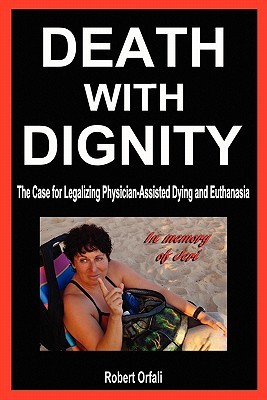Title: Death with Dignity: The Case for Legalizing Physician-Assisted Dying and Euthansia
Publisher: Mill City Press
ISBN: 9781836780181
Pages: 229, Paperback/Kindle
Genre: Non-Fiction/Current Events/Alternative Health
Author Interview with Robert Orfali
 Author Interview Series
Author Interview Series
Death With Dignity: The Case for Legalizing Physician-Assisted Dying and Euthanasia
Interviewed by: Beth Adams, Pacific Book Review
PBR: Today we have the pleasure of talking with Robert Orfali, author of Death With Dignity: The Case for Legalizing Physician-Assisted Dying and Euthanasia. First, please allow me to express my sincere sorrow for the loss of your wife, Jeri. From what you wrote she certainly appears to have been a remarkable woman, lover and soulmate.
RO: Thank you. Jeri certainly was a remarkable woman.
PBR: To talk about Jeri a bit more, if I may. Tell us about how she won that surfing contest while she was in her 50’s?
RO: Surfing was part of her detox therapy. Jeri was diagnosed with Stage 3 ovarian cancer. The survival rate for her cancer is less than three years. She survived almost ten years, but it was non-stop chemo during all those years. The cancer never went into remission. Surfing allowed her to bounce back from that horrible chemo. Jeri was very tough. She morphed from a Silicon Valley executive to a fiercely competent surfer while taking chemo.
PBR: Her strong will and competitiveness must have been something to inspire others. How have her friends been changed by all of this?
RO: Jeri was always the most radiant person in the room. She didn’t let the cancer define her. She inspired other cancer patients, her friends, and everyone around her. Her message to them was that there is life after cancer. In my case, Jeri taught me to live in the present. I savored every microsecond I had with her on this earth; it was beyond precious.
PBR: So tell us a bit how this book came to be written. You already wrote a book titled Grieving a Soulmate. Why didn’t you stop there?
RO: Being a terminal cancer patient, Jeri wanted some form of insurance at the end. She did not want to die in pain. She believed in physician-assisted dying and wanted to have the pills just in case. Unlike Oregon, the state of Hawaii maintains a prohibition against physician-assisted dying for the terminally ill. I wrote this book to help lift this cruel prohibition. I believe that terminally-ill patients must be given all the palliative choices they can get at the end. As part of my research for the first book, I discovered that our end-of-life system is pretty much broken. Modern medicine allows us to live longer, but the price we pay is prolonged dying often with suffering akin to “torture.” The sad truth is that 80% of Americans will not leave life the way they would have liked to: “at home and without needless suffering.” By closing our eyes and letting the system follow its course, over half a million of us may end up intubated in an ICU at the end of our lives. Hospice provides a gentler death but it has its own problems. For most, hospice comes too late. The median length of stay in hospice is, sadly, eighteen days, with 33% enrolled for just eight days or less. In addition, the practice of palliative sedation—the only way to alleviate terminal pain for many—varies dramatically among hospices: the variances are between 1% and 52%. The practice is very capricious. To protect ourselves and our loved ones, we need to understand our end-of-life choices. And, we need to think about them while we still can. It could make the difference between having a relatively good death and a very bad death. Yes, denial can have some serious ramifications. In my book I argue that legalized physician-assisted dying must be added to the hospice repertoire of palliative choices. By providing both, Oregon now has the best palliative-care system in America.
PBR: Have you found yourself to be thought of as controversial to the Catholic Church or other religious groups?
RO: I haven’t heard from them, yet. However, your question is on target because only the arguments based on religious faith remain intact. In my book, I make the case that there is no secular argument against lifting this cruel prohibition. Thirteen years of data collected in the state of Oregon show that there were no slippery slopes. No credible claim can be made that aid in dying exacerbates grieving outcomes, weakens hospice and palliative care, threatens people with disabilities, or discriminates against elders, minorities, or vulnerable populations.
PBR: For those that have not yet read your book, tell us please how does one know the “right time” to end their life – and take the drug Nembutal? What I mean is precisely the moment to do it.
RO: In Oregon, two doctors must determine that the patient is competent and has fewer than six months to live before they can prescribe the Nembutal. After this only the patient can decide when or if ever to self-administer the pills. Legalized assisted dying allows the patient full control over the exact timing of death. The patient can decide when enough is enough. It’s important that the choice of the time of death be made by the person who is dying. Typically, the family encourages their loved ones to hold on: we want to enjoy them as long as we can. However, unless you’re into sadism, there’s nothing enjoyable about watching a loved one being tortured by a disease in its final stages. It’s important to let them know that it’s okay to go. The decision of when to go is now firmly in their hands. Jeri had a vision of how she wanted to die, but she could have delayed her death as long as she wanted. There was no set date. Also, she didn’t have to go that way. All the choices would be hers to make, up to the very last second. And, she could always change her mind. We each have our own quality of life calculus. Pain and suffering is very subjective. Remember, for most terminally-ill patients this option is only a form of insurance. It gives them peace of mind that they have a gentle way out in case all else fails.
PBR: Are you currently pro-active in lobbying; or, perhaps I should simply ask, what you are doing to further your delivery of your message?
RO: I am currently lobbying to have the prohibition lifted in the state of Hawaii. It’s my tribute to Jeri. I’m also making the e-book available for $0.99. It’s as close to “free” as Amazon now allows for new e-books. I hope the e-book goes viral and helps inform people about their end-of-life choices.
PBR: What would you like to see done?
RO: I would like physician-assisted dying to become a palliative option for all terminally ill patients. It will help provide them peace of mind at the end. We can all learn from the Oregon experience. In a prefect world, it would be replicated in every state of the union. There is no reason for people to needlessly suffer at the end of their lives. We have the technology to help us die peacefully in our sleep. We must make it a choice for all terminally ill patients.
PBR: Aside from buying your book and reading it, what can others do to promote open discussions on this issue?
RO: First, please help me make the e-book go viral. I can’t do it alone. Second, try to encourage your friends and loved ones to spend a few hours familiarizing themselves with the workings of our end-of-life system. Tell them to read the first three chapters of my book. We will all die some day, so this matter affects us all. We must become more informed consumers. I believe that when people read these chapters they will become more involved. There’s just too much at stake, and no one wants to be tortured at the end of their lives. It’s best to do something about it while you still can before you cross that bridge. Call your legislators, blog about the issue, write letters to the editor, and send everyone a link to the “almost free” e-book.
PBR: I see. Thank you. We certainly wish you success with your book and your project. Once again, my sincere sympathies for your loss.
RO: Thank you for giving me this opportunity.
Visit author’s website
Read review of Death with Dignity
Read Death with Dignity in the Author Spotlight


